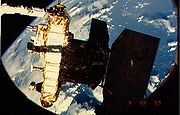
ERBS
Encyclopedia


NASA
The National Aeronautics and Space Administration is the agency of the United States government that is responsible for the nation's civilian space program and for aeronautics and aerospace research...
scientific research satellite
Satellite
In the context of spaceflight, a satellite is an object which has been placed into orbit by human endeavour. Such objects are sometimes called artificial satellites to distinguish them from natural satellites such as the Moon....
launched on October 5, 1984 to study the Earth
Earth
Earth is the third planet from the Sun, and the densest and fifth-largest of the eight planets in the Solar System. It is also the largest of the Solar System's four terrestrial planets...
's radiation budget and stratospheric aerosol gases. It was carried into low earth orbit
Low Earth orbit
A low Earth orbit is generally defined as an orbit within the locus extending from the Earth’s surface up to an altitude of 2,000 km...
and deployed by the Space Shuttle Challenger
Space Shuttle Challenger
Space Shuttle Challenger was NASA's second Space Shuttle orbiter to be put into service, Columbia having been the first. The shuttle was built by Rockwell International's Space Transportation Systems Division in Downey, California...
, during the STS-41-G
STS-41-G
STS 41-G was the 13th flight of NASA's Space Shuttle program and the sixth flight of Space Shuttle Challenger. Challenger launched on 5 October 1984, and conducted the second shuttle landing at Kennedy Space Center on 13 October...
mission. The spacecraft
Spacecraft
A spacecraft or spaceship is a craft or machine designed for spaceflight. Spacecraft are used for a variety of purposes, including communications, earth observation, meteorology, navigation, planetary exploration and transportation of humans and cargo....
was expected to have a two-year operation life, but ultimately, the mission provided scientific data about the Earth's ozone layer
Ozone layer
The ozone layer is a layer in Earth's atmosphere which contains relatively high concentrations of ozone . This layer absorbs 97–99% of the Sun's high frequency ultraviolet light, which is potentially damaging to the life forms on Earth...
for more than two decades.
Data on the ozone layer provided by ERBS was key in the international community's decision-making process during the Montreal Protocol
Montreal Protocol
The Montreal Protocol on Substances That Deplete the Ozone Layer is an international treaty designed to protect the ozone layer by phasing out the production of numerous substances believed to be responsible for ozone depletion...
Agreement, which has resulted in a near elimination of CFCs in industrialized countries.
ERBS was one of three satellites in the Earth Radiation Budget Experiment and carried two instruments as part of that endeavor: the ERBE scanner (three detectors that study longwave radiation, shortwave radiation
Shortwave radiation
Shortwave radiation is a term used to describe radiant energy with wavelengths in the visible , near-ultraviolet , and near-infrared spectra....
and total energy radiating from the Earth
Earth
Earth is the third planet from the Sun, and the densest and fifth-largest of the eight planets in the Solar System. It is also the largest of the Solar System's four terrestrial planets...
along a line of the satellite's path) and the ERBE non-scanner (five detectors measuring the total energy from the Sun
Sun
The Sun is the star at the center of the Solar System. It is almost perfectly spherical and consists of hot plasma interwoven with magnetic fields...
, and the shortwave and total energy from the entire Earth disk and the area beneath the satellite). The second ERBE Instrument was aboard the NOAA-9 satellite when it was launched in January 1985, and the third was aboard the NOAA-10 satellite when it was launched in October 1986.
In addition, it carried the Stratospheric Aerosol Gas Experiment
Stratospheric Aerosol and Gas Experiment
The Stratospheric Aerosol and Gas Experiment is a series of remote sensing satellite instruments used to study the chemical composition of earth's atmosphere. Specifically, SAGE has been used to study the Earth's ozone layer and aerosols at the troposhere through the stratosphere...
(SAGE II).
It was retired for budgetary reasons on October 14, 2005 as one of the longest-running spacecraft missions to date.
External links
- NASA's web site on ERBS
- http://www.energytribune.com/articles.cfm?aid=2665

